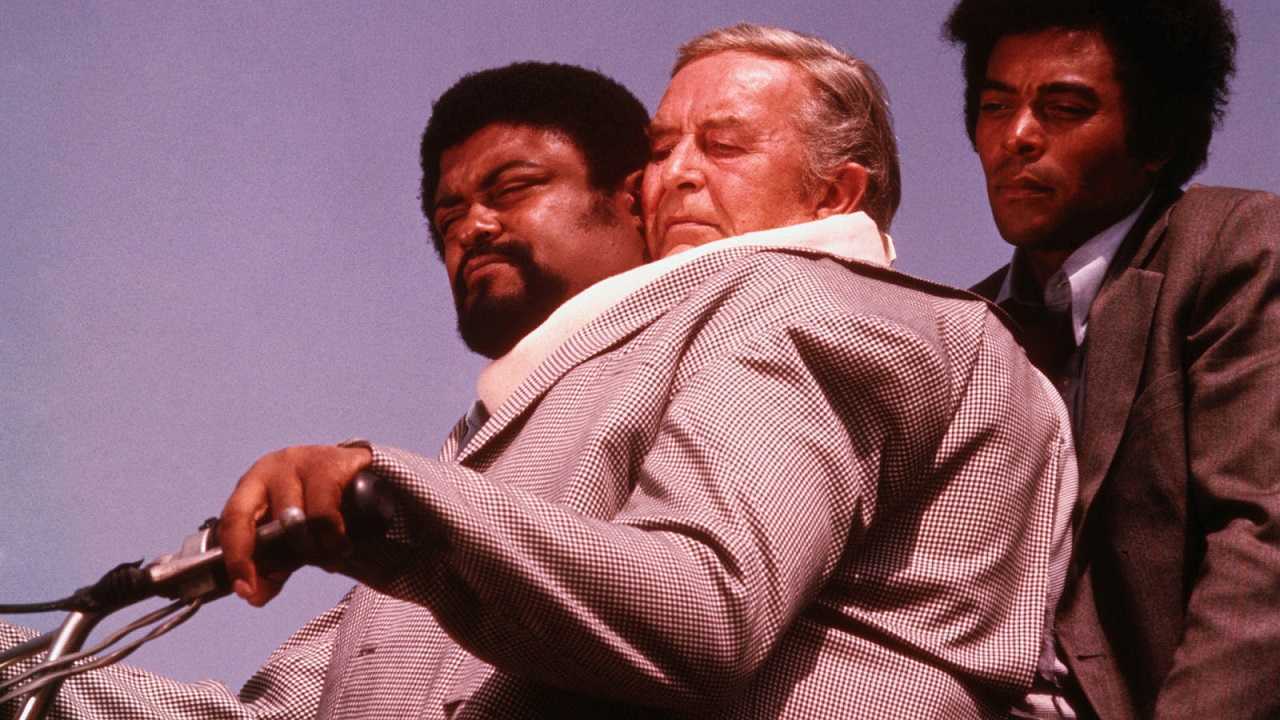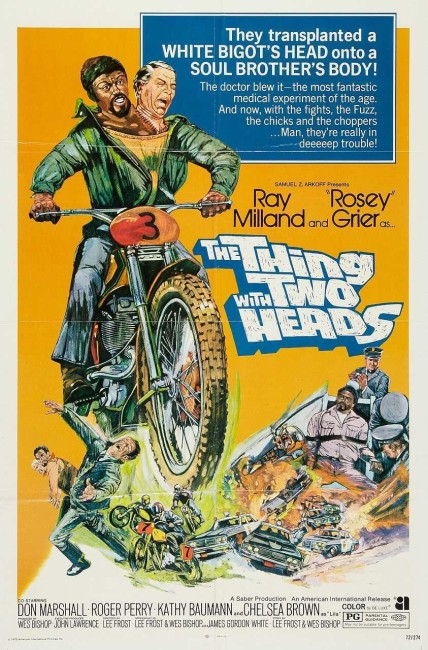USA. 1972.
Crew
Director – Lee Frost, Screenplay – Wes Bishop, Lee Frost & James Gordon White, Story – Wes Bishop & Lee Frost, Producer – Wes Bishop, Photography – Jack Steely, Music – Robert O. Ragland, Songs – Porter Jordan, Makeup Effects – Rick Baker, Tom Burman, Charles Schram & Dan Striepike. Production Company – Saber,
Cast
Ray Milland (Dr Maxwell Kirshner), Rosey Grier (Jack Moss), Don Marshall (Dr Fred Williams), Roger Perry (Dr Philip Desmond), Chelsea Brown (Lila)
Plot
Millionaire and genius surgeon Dr Maxwell Kirshner is diagnosed with terminal cancer. Kirshner has perfected a plan, which he has first experimented with on an ape, to have his head removed and transplanted onto another man’s body. The two heads must initially exist alongside until Kirshner’s head can obtain control of the body and the original owner’s head can then be removed. After a long and fruitless search, Kirshner’s medical team finally find Jack Moss, a prisoner on Death Row who is happy to accept the chance for a reprieve. However, when the racist Kirshner wakes up from the operation, he is appalled to find that he is sharing the body of a Black man. Kirshner and Moss are forced to cooperate as the two-headed Thing becomes a fugitive from the law.
There are some themes in genre cinema – like the killer bee movie and the disembodied brain/head movie – that automatically make for bad movies no matter what. One of these might also be the two-headed transplant movie. The first example of the two-headed transplant movie was the Japanese/American The Manster (1959). This mini-genre seemed to hit a height in the early 1970s with The Incredible 2-Headed Transplant (1971) and The Thing with Two Heads, which were both released by AIP (American International Pictures). During this period, Andy Milligan also made The Man with Two Heads (1972), although this has no two-headed transplants and is actually an adaptation of Dr Jekyll and Mr Hyde (1886). Even when the two-headed transplant theme is done with tongue planted in cheek, as in tv’s The Hitch Hikers Guide to the Galaxy (1981), it still ends up looking cheesy.
The Thing with Two Heads was directed by Lee Frost, who has mostly made nudie and softcore pornographic films throughout his career. Lead actor Ray Milland had become a star in the 1940s with his Oscar-winning role in The Lost Weekend (1945) but his career had gradually faded throughout the 1960s into a host of B movie parts during which time he had become a regular in horror cinema. Milland’s co-star was footballer Rosey Grier, a cousin to Pam whose largest claim to fame at that point had been as the man who grabbed Bobby Kennedy’s assassin Sirhan Sirhan. After a brief acting career, Grier later became famous for his needlepoint and macramé and then as a Christian minister.
The Thing with Two Heads jumps aboard the early 1970s fad for racially-themed films. In fact, at its core, The Thing with Two Heads is a madcap combination of a two-headed transplant film and The Defiant Ones (1958), the acclaimed Stanley Kramer drama that featured Sidney Poitier and Tony Curtis as a black and a white man on the run from the law while chained together.

The Thing with Two Heads received an instant bad movie reputation from the moment of its release. This probably says a good deal about how little some people actually see in films – it is hard to believe that the film could have been made without any of it being intended as tongue-in-cheek. Certainly, if one looks at the film in the spirit it was clearly intended, it is rather entertaining. The heads are never convincing – for anything other than medium angle, Ray Milland’s head becomes a shoddy latex cast sitting on Rosey Grier’s shoulders, and in closeup the two actors have to conduct some amazing contortions to both fit into the same collar.
By the last third of the film, any pretence of seriousness is abandoned altogether and Lee Frost revels in a total silliness with the Thing entering a motorcycle race where it succeeds in winning. There is nothing more deliriously absurd than the sight of the two-headed Thing nonchalantly zooming about stunt-cycling, or a car chase with the Thing pursued around a field in circles by about a dozen cop cars. The ending hits a perfect note as the Black trio drive off into the night, conducting a Gospel rendition of Oh Happy Day. A young Rick Baker created a two-headed ape that gets loose in the early scenes – in one hilarious moment, it is captured after being found sitting in the middle of a supermarket aisle chewing on bananas.
Director Lee Frost had a prolific career in exploitation, including titles such as Chain Gang Women (1971), Chrome and Hot Leather (1971) and the Blaxpolitation classic The Black Gestapo (1975). His other genre films included House on Bare Mountain (1962), a nudie with appearances from the Famous Monsters; the Naziploitation film Love Camp No 7 (1969); Witchcraft 70 (1970), a documentary exploiting the early 1970s occult fad; and the psycho film Zero In and Scream (1971).
Trailer here


